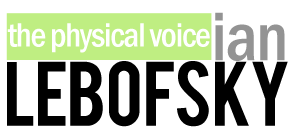1. True Vocal Folds: Onset/Offset Control:
In this figure there are three options:
Glottal - folds close before expiration. as in vocalizing the vowels i e a o u. There is a “pop” before the sound. Tends to initiate a louder sound ( see Vocal fold body cover) A great exercise for beginning to feel your vocal folds*(chords) touch.
Asperate - Folds close after expiration. Sound starts with an h. Tends to initiate a breathy tone. ( see Vocal fold body cover)
Smooth - closure and expiration happen simultaneously. No “h” or pop before the tone. Like a smooth bowed violin attack . . Tends to initiate a soft tone. ( see Vocal fold body cover)
2. False Vocal Folds Control:
This figure teaches the student how to keep the feeling of an open throat (retracted false folds). If it scratches or tickles at the larynx when you sing you are constricting the false vocal folds which can lead to voice problems. The silent laugh technique, developed into an exercise by Jo Estill, is widely cited as reducing false vocal fold constriction.
3. True Vocal Folds: Body - Cover Control:
The body refers to the vocalis muscle and ligament. Cover is the lamina propria and epithelium. This figure demonstrates the controlled use of the vocal folds in four body-cover configurations:
thick edge - louder
thin edge - softer
stiff mode - somewhat breathy, or falsetto
slack mode - vocal fry or the creaky door sound
This figure will help
- learn to avoid breaks and keep the voice consistent through the range
- learn to put in planned vocal breaks as in "cracking with emotion" and the country yodel
- learn to do sudden dynamic changes for effect or emphasize certain word in the song
4. Thyroid Cartilage Control
The tilted thyroid gives us that sweet “singing” tone. It aids in developing a pleasant vibrato. It can also aid in smoothing out those register shifts (breaks or passagio) The student learns to engage the cricothyroid muscle and tilt the thyroid by adopting the posture of crying or sobbing or making a soft whimpering noise, like a small dog whining. The horizontal thyroid tends to give us a more speachy sound. In short, the position of the thyroid cartilage influences not only pitch but also the quality and intensity of the sound produced.
5. Cricoid Cartilage Control:
With t this figure we learn control of the position of the cricoid cartilage. Tilting the cricoid forward is part of the vocal set-up for shouting Belting and other high-intensity voice production
6. Larynx Control
If you’ve ever blown across the top of a bottle you probably noticed that as the bottle empties the note is lower in pitch. This is because lower notes need a longer resonator (empty bottle) while higher notes need a shorter resonator (fuller bottle).
The larynx usually lowers for low notes to make the vocal tract longer and raises for high notes to shorten the resonator. We can however consciously change the larynx height to effect the tone quality. This figure trains raising and lowering of the larynx. A lower larynx produces the darker sound featured in classical singing but can be used any time a richer sound is required. A higher larynx brightens and “thins” the quality of the voice.
7. Velum Control:
This figure trains the velum (also known as the soft palate).. This structure controls how nasal the sound is An open or partially open velar port filters out high frequencies and can soften the tone. A closed velar port allows no sound through the nose thus the voice tends to be brighter and more full.
8. & 9. Head and Neck Anchoring & Torso Anchoring:
Head, neck and torso anchoring are true support. You will learn how to get a lot of bang for the buck as far as power is concerned. The student learns to use the relatively large muscles of the head/neck and torso to steady the larynx freeing the small muscles of the vocal tract to make the micro movements necessary to control pitch and quality. Also aids in negotiating breaks in the register.
10. The Twanger (Aryepiglottic Spincter Control):
This figure teaches true projection. We add power(as much as 20 decibels) by adding brightness to the voice, making it stand out to the listener. The student learns to consciously narrow the area just above the Laryngal vestibule creating a very bright resonance (2500-5000hz)also known as Squillo or the singers formant. With this figure we must be careful be careful not to constrict the False Focal Folds
11. Tongue:
The student learns to manipulate several parts of the tongue independently. For High notes and/or brightness we want a higher tongue. For lower notes and/or a more full sound we lower the tongue.
12. & 13. Jaw & Lip Control:
Both act as tongue controls (treble & bass).Jaw forward makes it brighter and jaw back makes it darker.
Lips protruted makes your sound darker.
Born | Montreal, 1951


